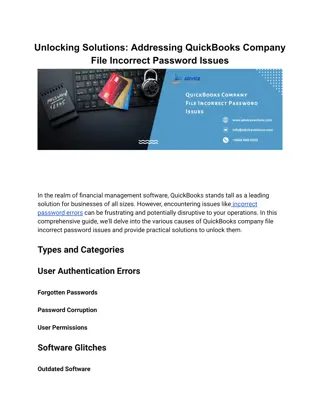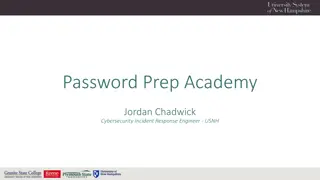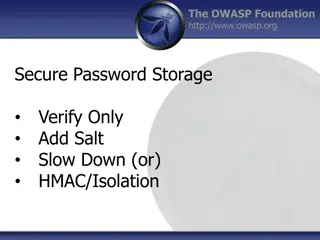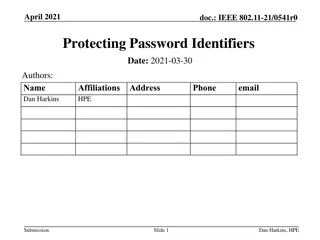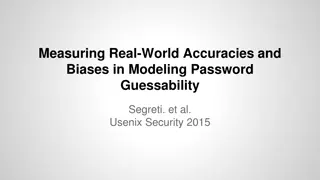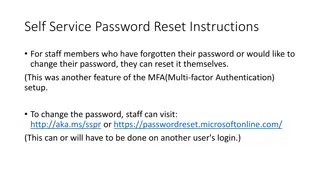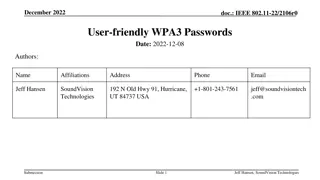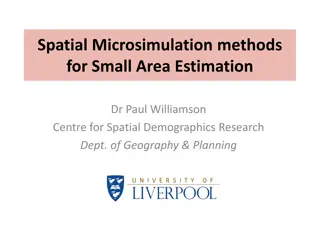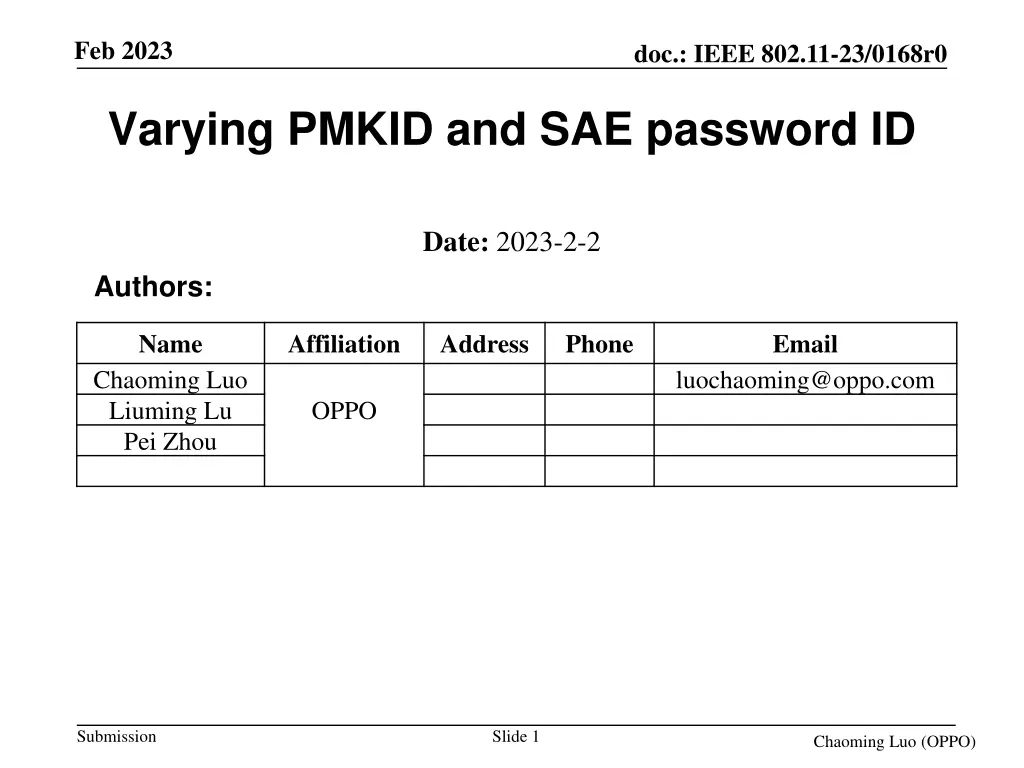
Varying PMKID and SAE Password Identifier Method Overview
Learn about a proposed method to vary PMKID and SAE password identifier in the IEEE 802.11-23/0168r0 document for enhanced wireless security and privacy. The method aims to prevent eavesdroppers from distinguishing authentication and reassociation exchanges, ensuring robust network protection. Discover insights into PMKID and SAE password ID generation, maintenance, and derivation following successful associations. Explore how the STA and AP generate new PMKIDs and SAE password IDs to enhance network security.
Uploaded on | 2 Views
Download Presentation

Please find below an Image/Link to download the presentation.
The content on the website is provided AS IS for your information and personal use only. It may not be sold, licensed, or shared on other websites without obtaining consent from the author. If you encounter any issues during the download, it is possible that the publisher has removed the file from their server.
You are allowed to download the files provided on this website for personal or commercial use, subject to the condition that they are used lawfully. All files are the property of their respective owners.
The content on the website is provided AS IS for your information and personal use only. It may not be sold, licensed, or shared on other websites without obtaining consent from the author.
E N D
Presentation Transcript
Feb 2023 doc.: IEEE 802.11-23/0168r0 Varying PMKID and SAE password ID Date: 2023-2-2 Authors: Name Affiliation Address Phone Email Chaoming Luo Liuming Lu Pei Zhou luochaoming@oppo.com OPPO Submission Slide 1 Chaoming Luo (OPPO)
Feb 2023 doc.: IEEE 802.11-23/0168r0 Introduction A method to vary PMKID and SAE password identifier is proposed. Submission Slide 2 Chaoming Luo (OPPO)
Feb 2023 doc.: IEEE 802.11-23/0168r0 Recap: requirement R1: 11bi shall define a mechanism to prevent an eavesdropper distinguishing whether authentication exchanges between CPE Clients and CPE AP use identical SAE credentials or distinct SAE credentials (where a CPE AP supports multiple SAE credentials). R2: 11bi shall define a mechanism to prevent an eavesdropper distinguishing whether reassociation exchanges between CPE Clients and CPE APs use identical PMK or distinct PMK. Submission Slide 3 Chaoming Luo (OPPO)
Feb 2023 doc.: IEEE 802.11-23/0168r0 Discussion: PMKID Following full association, PMKID is transmitted by the Client in the clear prior every reassociation (until the Client performs another association) to identify the PMK. o 12.6.1.1.2 PMKSA: The PMKSA is created by the Authenticator s SME and Supplicant s SME when EAP authentication, SAE authentication, FILS authentication, or an OWE exchange completes successfully, or when the PSK is configured. o 12.6.1.1.2 PMKSA: The PMKID derived from the KCK during the initial 4- way handshake is not changed during the lifetime of the PMKSA. In short, PMKID exists per tuple <AP, Client, association>. An AP may maintain multiple PMKIDs for different Clients; A Client may maintain multiple PMKIDs for different APs. 21/1697r0 proposed a good method to derive a new PMKID after every reassociation (PMK keeps no change), so that it exists per tuple <AP, Client, reassociation>. Submission Slide 4 Chaoming Luo (OPPO)
Feb 2023 doc.: IEEE 802.11-23/0168r0 Discussion: SAE password ID The SAE password identifier, is used to identify different passwords. By default, a BSS has one SAE password and one SAE password ID. However, it is possible that a BSS maintains multiple SAE password and SAE password IDs, and even further, each SAE password could have multiple IDs. o Clause 12.4.4.2.3: when Hash-to-element generation of the password element with ECC groups is used, a password identifier may be used. o Clause 12.4.4.3.3: when direct generation of the password element with FFC groups, a password identifier may be used. o pwd-seed = HKDF-Extract ( ssid, password [ || identifier ] ) A similar method as deriving PMKID could be considered to derive SAE password ID per tuple <AP, Client, reassociation> using PTK. Submission Slide 5 Chaoming Luo (OPPO)
Feb 2023 doc.: IEEE 802.11-23/0168r0 Proposal PMKID: as proposed by 21/1697r0, the STA and AP generate a new PMKID at each successful (re)association. Each PMKID is derived using the PTK (detail algorithm is TBD). SAE password ID: the STA and AP generate a new SAE password ID at each successful (re)association. Each SAE password ID is derived using the PTK (detail algorithm is TBD). Submission Slide 6 Chaoming Luo (OPPO)
Feb 2023 doc.: IEEE 802.11-23/0168r0 SP 1 Do you agree 11bi shall incorporate the proposed method describe in slide 6? Y/N/A Submission Slide 7 Chaoming Luo (OPPO)
Feb 2023 doc.: IEEE 802.11-23/0168r0 Reference [1] P802.11REVme_D2.1 [2] 11-21-1848-16-00bi-requirements-document [3] 11-21-1697-00-00bi-mac-privacy-and-pmksa-caching [4] 11-22-0107-02-00bi-initial-privacy-enhancement- requirements Submission Slide 8 Chaoming Luo (OPPO)

